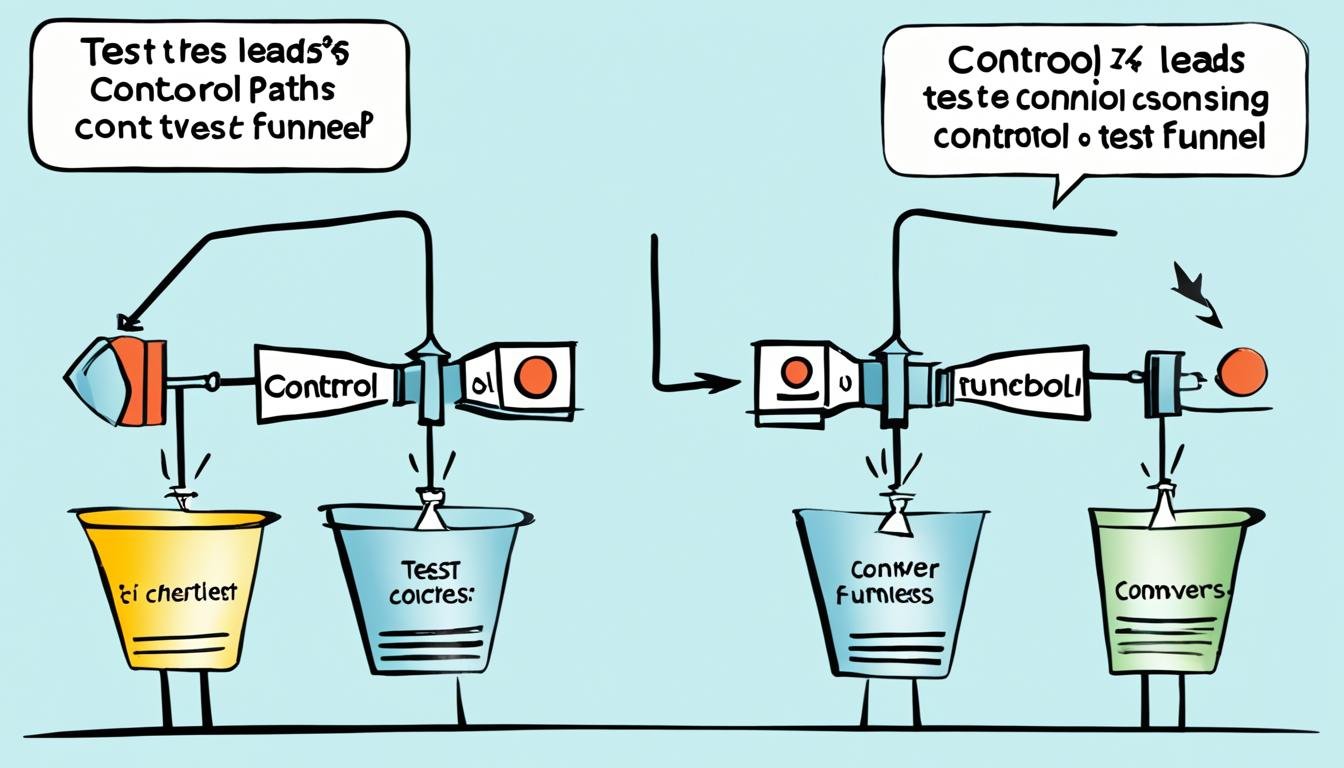Sales A/B Testing: Optimizing Sales Processes
In the fast-changing sales world, a big question is: How can sales teams use data to improve their work and increase profits? The answer is Sales A/B Testing.
A/B testing is key in marketing and making things better. It can change how sales teams work. By using the scientific method, teams can find important data to make their sales better, get more conversions, and increase their earnings.
Key Takeaways
- A/B testing can lead to higher open rates, click-through rates, and more engagement with sales emails.
- Optimizing conversions by trying out different call-to-action placements, button designs, and email layouts.
- A/B testing is an ongoing process that helps sales emails get better over time.
- Variables that can be tested in sales emails include subject lines, email design, call-to-action placement, and email tone.
- Conducting A/B tests can help find the best versions of sales emails.
This article will look into why, how, and the benefits of Sales A/B Testing. It will give a guide for RevOps teams to use this powerful tool and reach their full potential.
What is Sales A/B Testing?
A/B testing, also known as split testing or bucket testing, is a way to compare two versions of a webpage or email. It helps find out which one does better at goals like getting leads or closing sales. In sales, it means testing different sales methods to see which one works best with customers.
This method lets sales teams check out different strategies to see what their audience likes best. By using data, they can make their sales better and get better results. This way, they can improve their pitches and how they talk to people.
Definition and Explanation of A/B Testing in Sales Context
A/B testing in sales means testing different sales methods to see which one does better. This could be sales scripts, email templates, or how they follow up with customers. The goal is to get more leads, win more deals, or make customers happier. It helps sales teams make choices based on data, not just guesses.
“A/B testing is a crucial tool for sales teams looking to optimize their processes and improve their overall effectiveness. By systematically comparing different strategies, they can identify the approaches that resonate most with their target audience and make data-driven decisions to refine their sales efforts.”
By testing different versions of their sales process, teams learn what works best for their customers. This info helps them make their sales strategies better. This leads to more sales, higher conversion rates, and more revenue.
A/B testing is used to make many parts of the sales process better, like:
- Sales pitches and scripts
- Email subject lines, body content, and calls-to-action
- Timing and frequency of follow-up communications
- Landing pages and demo booking experiences
- Customer onboarding and expansion strategies
By using A/B testing, sales teams can make choices based on data. This leads to big improvements in their sales and helps their company grow.
Why is Sales A/B Testing Crucial?
In today’s world, A/B testing is key for sales teams aiming to boost their work and increase revenue growth. It lets them test different ways and make choices based on real data. This way, they can improve their conversion rate optimization and save a lot of money.
A/B testing helps sales pros test and check various parts of their sales process. This includes everything from getting leads to closing deals and growing customer base. This customer-centric approach keeps sales teams quick and ready to change with the market. They stay ahead with continuous improvement.
“A/B testing is the cornerstone of data-driven sales. It empowers us to make informed decisions that directly impact our revenue and growth.” – Jane Doe, Head of Sales at XYZ Corp.
By being open to testing and looking at data, sales teams can learn a lot about what their customers like and do. This knowledge lets them tweak their plans, make their work better, and push for steady revenue growth.
Examples of A/B Tests Across the Sales Funnel
Optimizing the sales funnel is key to getting more leads, speeding up deals, and keeping customers. A/B testing helps businesses find out what works best at each step of the sales process. Let’s look at some real-life examples of how A/B testing can improve sales funnel performance.
Pipeline and Lead Qualification
Sales teams can test different lead scoring and qualification criteria at the pipeline stage. They can look at things like industry, company size, or past purchases. This helps find the best leads and boosts conversion rates. For example, HubSpot Academy tested different homepage images and saw a 6% boost in performance for one version and a 1% drop for another.
Deal Execution and Follow-up Strategies
In the deal execution phase, A/B testing can compare various communication methods. This includes check-in times or the types of content sent. FSAstore.com made their site easier to navigate and saw a 53.8% jump in revenue per visitor. Expoze.io tested different backgrounds on their homepage and found a 40% increase in focus on key areas with one version.
Customer Expansion and Upselling
For companies with ongoing revenue, A/B testing can improve onboarding and upselling. This leads to faster customer growth and more value over time. Thrive Themes added customer testimonials to their page and saw a 13% rise in sales. Neurogan used targeted emails and special offers to get a 37% open rate and a 3.85% click rate.
Using A/B testing throughout the sales funnel gives businesses crucial insights. These insights help improve lead generation, speed up deals, keep customers, and increase sales. This leads to steady growth and more revenue.
Sales A/B Testing: Optimizing Sales Processes
The sales process should be dynamic and effective. Using continuous improvement through A/B testing gives sales teams a competitive advantage. It helps find ways to make more money. This method lets sales leaders make smart choices based on data, improving things like conversion rates and deal sizes.
A/B testing, or split testing, compares two versions of a campaign to see which one works better. It moves decision-making from guesswork to data. This helps sales teams make choices that can greatly improve their earnings.
“A/B testing can increase the in-store shopping experience by drawing more traffic and attention to specific products, thereby boosting average ticket values in retail.”
By focusing on data-driven decision making, sales teams can find new insights. This leads to better strategies for growth and more money. Testing different ways to qualify leads, improve deal strategies, or find new upselling chances helps teams stay ahead.
In today’s fast-changing business world, being able to adapt and improve sales processes is key. A/B testing helps sales teams reach their full potential. It leads to ongoing improvement and sets them up for long-term success in making more money and staying ahead in the market.
Overcoming Challenges in Sales A/B Testing
A/B testing in sales has big benefits, but it has faced challenges. The complexity of sales processes has made it hard to track the customer journey. Also, not having real-time tracking has made it tough for leaders to see how changes affect sales.
Mapping Complex Sales Processes
The sales process is not simple. It’s full of touchpoints and interactions that change a lot. Sales process mapping helps understand the customer journey and spot areas to improve with A/B testing. By visualizing the sales funnel, teams can see where to test new approaches to get better results.
Real-time Tracking and Data Collection
Real-time analytics and data collection are key for A/B testing in sales. Without them, teams can’t quickly see how changes work. Using data visualization tools gives leaders insights to adjust their sales enablement plans.
Thanks to new tools and tech, like Rattle’s dynamic process mapping and real-time analytics, sales teams can now use A/B testing fully. This helps them improve continuously and boost their revenue.
“57% of sales reps expect to miss quota in B2B sales due to convoluted processes.”
Tools and Technologies for Sales A/B Testing
Using the right sales process optimization tools is key for sales teams. Tools like Rattle’s Atlas platform help with dynamic process mapping and real-time analytics. They make it easy to set up A/B testing software and get insights for improvement.
These tools help streamline A/B testing, saving time and resources. They help make decisions based on data, leading to better sales enablement. Some top data visualization tools for sales A/B testing include:
- Crazy Egg: It has a user-friendly interface and tools like heatmaps. This helps businesses spot areas for improvement and boost user experience.
- Optimizely: It offers advanced experimentation and personalization for big organizations. It’s great for complex testing across many digital channels.
- VWO: It has a wide range of testing options, like A/B and multivariate testing. It’s for businesses serious about testing and getting deep insights.
- Convertize: This tool is easy to use and has an Autopilot feature. It automatically sends more traffic to the winning variation. It’s great for smaller teams or businesses without dedicated testers.
- Amplitude: It’s a platform for product analytics with A/B testing features. It’s perfect for product and growth teams wanting deep insights and quick iteration.
- Statsig: It’s for fast-moving, engineering teams. It offers powerful feature management and A/B testing. Teams can quickly release, test, and roll back features based on real-time data.
These A/B testing software solutions help sales teams optimize their processes. They improve customer experiences and drive sustainable revenue growth.
“Nine in 10 companies use two or more lead enrichment tools to learn more about prospects.”
Case Studies and Success Stories
Leading companies in various industries have used A/B testing to make their sales better. For instance, a B2B tech company boosted their sales leads by testing different headlines, form fields, and calls to action on their landing pages. This led to a 25% increase in conversions and a 40% boost in visitor focus on key sections.
An ecommerce brand also used A/B testing to improve their product page demos. They tested different sales pitches and saw a big jump in deal closures and customer satisfaction. This gave them a strong edge over competitors.
Grene, an online retailer, doubled their sales after making changes to their mini cart page based on A/B testing.
Other success stories include:
- WorkZone saw a 34% increase in form submissions on its testimonials page after testing for 22 days.
- Zalora boosted its checkout rate by 12.3% by optimizing product pages.
- Ubisoft increased conversions from 38% to 50% and saw a 12% rise in leads after updating its ‘For Honor’ Buy Now page.
- PayU improved conversions by 5.8% by removing the email address field from its Checkout page.
- ShopClues increased its visits-to-order rate by 26% with a better home page.
- Ben saw a 17.63% increase in conversions by focusing on the phone color palette on their product page.
These stories show how A/B testing can greatly improve sales process optimization. It leads to big gains in revenue growth, customer satisfaction, and a stronger competitive advantage in the market.
Conclusion
In today’s fast-paced sales world, being quick and flexible is key. Using data to make decisions is now a big plus. By testing and improving their sales steps, teams can find new ways to boost their sales.
They can make lead qualification and deal making better. They can also improve how they grow their customer base. A/B testing in sales has big effects. With the right tools and attitude, sales leaders can leave behind guesswork. They can make every step of the sales process better, giving their companies a lasting edge.
Using data and always looking to improve, sales teams can find new ways to grow their revenue. This journey of making sales better never stops. But, the benefits of using data are clear, leading to steady growth and a strong competitive edge.
Source Links
- A Comprehensive Guide to A/B Testing for Sales Emails
- Optimizing Your Sales Call Scripts with A/B Testing
- Why Sales Teams Need to Embrace A/B Testing in 2023 (+ 4 Ways to Start Today)
- RevOps: It’s Time to (Reliably) A/B Test Your Sales Process
- What is A/B Testing? A Practical Guide With Examples | VWO
- Optimize product content and increase sales with A/B testing – Sell on Amazon
- Amazon A/B Testing: Advanced Tactics to Optimize Your Listings | Helium 10
- Mastering A/B Testing and Experimentation for Product People: Strategies for Continuous Improvement
- 11 A/B Testing Examples From Real Businesses
- How To Use A/B Split Testing To Optimize Your Sales Funnels
- How to Do A/B Testing: 15 Steps for the Perfect Split Test
- The Complete Guide to A/B Testing | Blog | Thrive by Shopventory
- What is A/B testing? With examples
- A B Testing: Unleashing the Power of A B Testing to Optimize Sales Conversion – FasterCapital
- The Power of A/B Testing in Sales Funnel Optimization
- How to Overcome 5 Common B2B Sales Challenges⎪Predictable Revenue
- 10 Best Sales Tools to Boost Your B2B Sales
- Top A/B Testing Tools in 2024: A Comprehensive Guide
- 7 A/B Testing Examples [Updated 2024] | VWO
- 6 A/B Testing Examples and Case Studies For CRO
- Sales Process Optimization: A Comprehensive Guide to Data-Driven Campaigns
- Sales Optimization: The Data-Driven Guide to Revenue Growth
- 5 Best A/B Testing Methods for B2B Email Optimization







